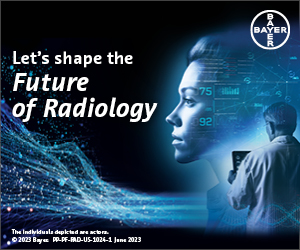|
E-Newsletter • August 2023 |
▼ ADVERTISEMENT
 
Editor's E-Note
Obesity increases people’s risk for a number of health conditions. It is also more challenging to image people with obesity. Researchers at the Icahn School of Medicine in New York have developed a PET radiotracer that can image obese individuals more clearly and with less radiation. Read all about it in the month’s newsletter.
Let us know on Twitter and/or Facebook how you like the newsletter.
— Dave Yeager, editor |
|
|
|
▼ ADVERTISEMENT
 |
Novel Radiotracer Demonstrates High Diagnostic Efficacy for Obese CAD Patients
A novel PET perfusion radiotracer, 18F-flurpiridaz, can diagnose coronary artery disease (CAD) in obese patients with a higher sensitivity and specificity compared with 99mTc-SPECT myocardial perfusion imaging (MPI), according to research presented at the 2023 SNMMI Annual Meeting. 18F-flurpiridaz PET MPI obtained images at a lower radiation dose than 99mTc-SPECT MPI and performed similarly in both obese and nonobese patients.
Obese individuals frequently have medical conditions such as diabetes, high cholesterol, and high blood pressure that put them at higher risk of developing CAD. Due to these risk factors, imaging obese patients for CAD is very important.
“Due to their body shape, it’s often hard to image obese individuals,” says Krishna Patel, MD, an assistant professor of medicine and cardiology at the Icahn School of Medicine at Mount Sinai in New York. “This can result in inferior image quality and diagnostic performance despite requiring a higher dose of radiation.”
|
Researchers Discover Breakthrough for Treatment-Resistant Lung Cancers
Numerous treatments exist to combat various forms of lung cancers; however, some cancers have acquired resistance to those treatments. Researchers from Yale School of Medicine and the Dana Farber Cancer Institute have discovered new vulnerabilities in these treatment-resistant cancers.
Simple Bone Screening Calculates Heart Attack Risk
A study published in eBiomedicine revealed that bone density tests can predict patients’ risk of a heart attack by measuring the level of calcium in the aorta.
Contrast-Enhanced MRI Reveals Risk Factor in Dense Breasts
Higher volumes of background parenchymal enhancement, the level of normal fibroglandular tissue breast MRI reveals, correlate with an increased risk of breast cancer. The research was published in Radiology. |
“As with positron emission tomography, which relies on the administration of radioactive substances as markers, this method has the great advantage of being sensitive and fast without 'seeing' interfering background signals from tissue or bone. … This is a first important step towards radiation-free intervention. MPI has the potential to change this field for good.”
|
|
|
COVER STORY
Inside the Algorithm
Rather than asking how an AI algorithm works, it is in the best interest of radiologists to ask how often these algorithms work and assess the value they add to radiology departments.
FEATURE
Uncommon Insight
Radiologists are advocating to make radiomics a staple of their practices for its ability to help identify medical conditions sooner.
|
|
|
| Advertising Opportunities |
Have a product or service you want to market to radiology professionals? Utilize the reach of Radiology Today Magazine to accomplish your marketing goals. Email our experienced account executives today at sales@gvpub.com or call 800-278-4400 for more information.
|
| © 2023 Radiology Today Magazine |
|
|